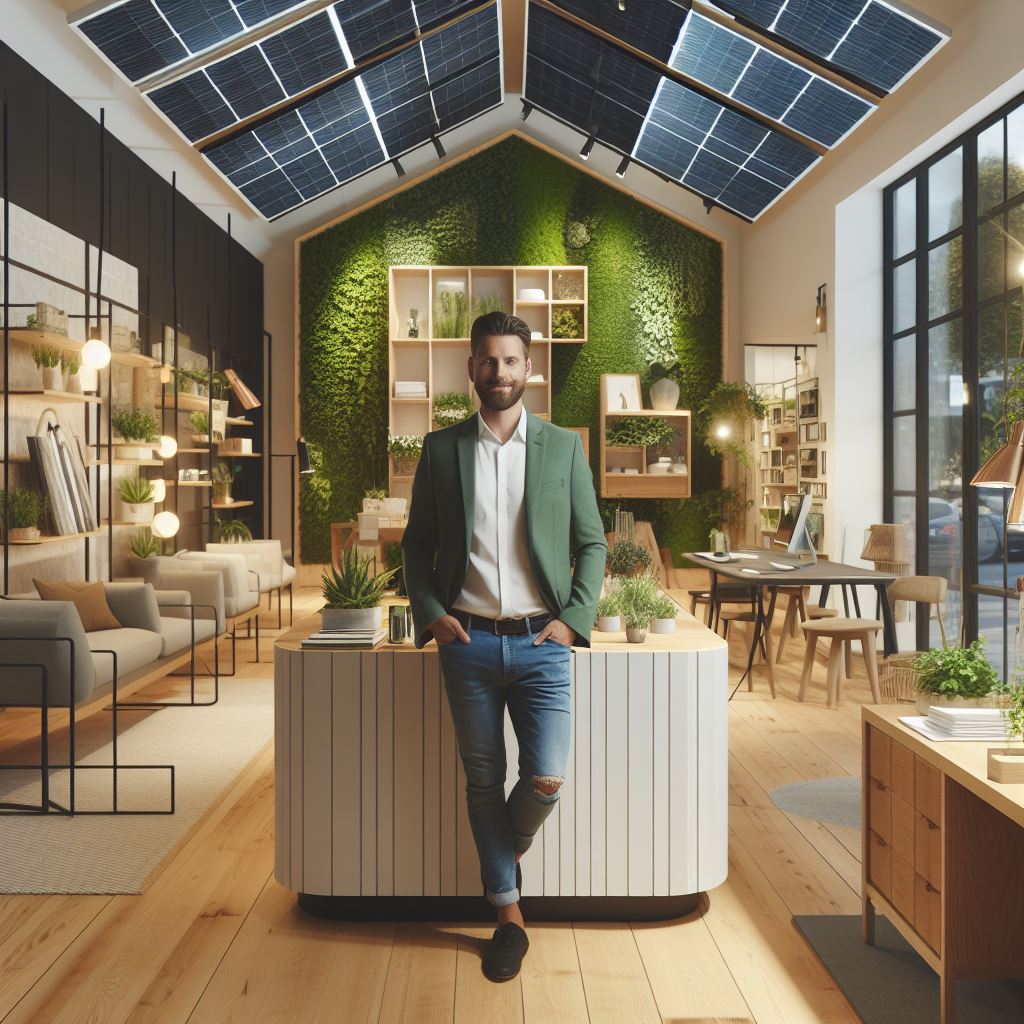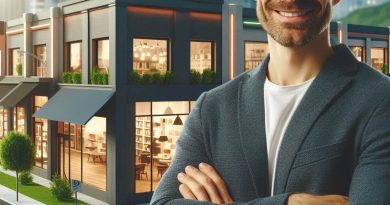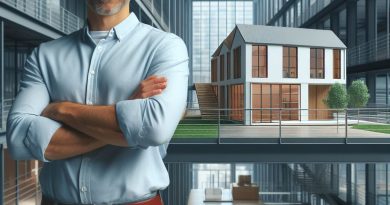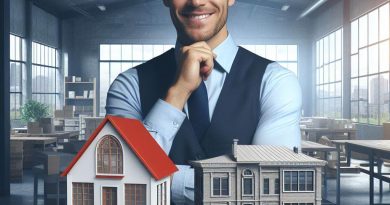Sustainable Design in Retail Properties
Last Updated on February 4, 2024
Introduction
Sustainable design focuses on creating environmentally-friendly and energy-efficient retail properties.
It is crucial to implement sustainable design in retail properties because it promotes environmental conservation, reduces operating costs, and attracts environmentally-conscious customers.
This blog post will provide an overview of the importance of sustainable design in retail properties and how it can be integrated into the design and construction processes.
Sustainable design encompasses various strategies such as energy-efficient lighting, using recycled materials, implementing green roofs, and optimizing natural ventilation.
By incorporating these strategies, retail properties can reduce their ecological footprint and contribute to a more sustainable future.
Retailers can benefit from sustainable design by reducing energy consumption, minimizing waste, and lowering operating costs.
Additionally, sustainable design can enhance the shopping experience by creating a healthier and more comfortable environment for customers.
Furthermore, retail properties that prioritize sustainable design are likely to attract a growing consumer base that values environmental responsibility.
This post will provide insights into the benefits, challenges, and best practices associated with sustainable design in retail properties.
Stay tuned to learn more about how sustainable design can transform the retail industry for the better.
Benefits of Sustainable Design in Retail Properties
Sustainable design in retail properties offers numerous benefits, categorized into environmental, economic, and social aspects.
Environmental Benefits
From an environmental perspective, sustainable design leads to a reduction in energy consumption.
By implementing energy-efficient lighting systems, optimizing insulation, and utilizing renewable sources of energy, retail properties can significantly decrease their energy usage and carbon footprint.
Conservation of water resources is another crucial environmental benefit.
Sustainable design practices, such as installing low-flow fixtures, rainwater harvesting, and water-efficient landscaping, help in preserving and conserving water resources.
By reducing water waste, retail properties contribute to sustainable water management.
Minimizing waste production is also a core aspect of sustainable design.
Retail properties can adopt recycling programs, implement efficient waste management systems, and encourage customers to use reusable bags.
By minimizing waste generation, these properties reduce the amount of waste sent to landfills and promote a circular economy.
Preservation of natural habitats is yet another advantage of sustainable design in retail properties.
By sourcing materials responsibly, retail properties can help protect ecosystems and wildlife habitats.
Additionally, implementing green roofs or incorporating green spaces into the design can provide habitats for local fauna and contribute to urban biodiversity.
Economic Benefits
The economic benefits of sustainable design in retail properties are significant.
One of the primary advantages is lower operating costs.
By reducing energy and water consumption, sustainability measures directly translate into cost savings.
Efficient lighting, HVAC systems, and water management strategies can result in substantial reductions in utility bills.
Moreover, retail properties with sustainable design features tend to have higher market value.
Potential buyers and tenants increasingly value environmentally-friendly properties, making them more appealing in the real estate market.
Sustainable design demonstrates a commitment to long-term efficiency and reduced environmental impact, making retail properties more attractive and desirable.
The attraction of eco-conscious customers is another economic advantage.
Sustainable design helps retail properties tap into a growing market of consumers who prioritize sustainability.
By showcasing environmentally-friendly features and promoting sustainable practices, retail properties can attract and retain customers who align with their values.
Furthermore, retail properties with sustainable design elements may qualify for energy-saving incentives or grants offered by government or utility companies.
These financial incentives can offset initial investments and provide additional economic benefits.
Social Benefits
The social benefits of sustainable design in retail properties are equally important.
By promoting better indoor air quality, retail properties ensure a healthier environment for customers and employees.
This is achieved through proper ventilation systems, indoor plant installations, or the use of low-emission materials.
Enhanced customer experience is another social benefit. Sustainable design elements, such as natural lighting, green spaces, and efficient store layouts, create a pleasant and unique shopping experience.
Customers appreciate the thoughtfulness behind sustainable design, leading to increased satisfaction and loyalty.
Retail properties play an essential role in supporting local communities and economies.
Sustainable design often prioritizes the use of locally sourced materials and products, fostering economic growth within the community.
By supporting local businesses, retail properties contribute to local job creation and sustainable economic development.
Finally, adopting sustainable practices helps build a positive brand reputation.
Customers increasingly value businesses that prioritize sustainability, and retail properties that demonstrate their commitment to the environment can gain a competitive edge.
This positive brand image attracts environmentally-conscious consumers, leading to increased customer loyalty and market share.
Overall, sustainable design in retail properties offers environmental, economic, and social benefits.
By reducing energy consumption, conserving water resources, minimizing waste production, and preserving natural habitats, retailers can contribute to a more sustainable future.
The economic advantages, such as lower operating costs, increased property value, and the attraction of eco-conscious customers, make sustainable design a wise investment.
Additionally, the social benefits, such as improved air quality, enhanced customer experience, and support for local communities, contribute to the overall well-being and positive reputation of retail properties.
Read: Eco-Friendly Offices: A New Real Estate Era

Key Elements of Sustainable Design in Retail Properties
Sustainable design in retail properties encompasses various key elements that contribute to its overall environmental impact and efficiency.
By incorporating these elements into the design and operation of retail spaces, owners can create eco-friendly and sustainable environments while also reaping the benefits of reduced energy consumption and lower operating costs.
Energy Efficiency
One crucial element is energy efficiency. Retail properties can achieve energy efficiency by installing renewable energy sources such as solar panels or wind turbines.
Additionally, the use of energy-efficient lighting and equipment, such as LED lights and high-efficiency HVAC systems, can significantly reduce energy consumption.
Proper insulation and sealing help minimize heat loss or gain, further optimizing energy efficiency.
Water Conservation
Water conservation is another critical aspect of sustainable design in retail properties.
Implementing efficient plumbing fixtures, such as low-flow toilets and faucets, reduces water usage.
Rainwater harvesting systems can collect and store rainwater for non-potable uses like irrigation, reducing reliance on municipal water supplies.
Landscaping with low-water plants minimizes irrigation needs, leading to substantial water savings.
Materials and Resources
The choice of materials and resources plays a significant role in sustainable design.
Using eco-friendly and recycled materials, such as reclaimed wood or recycled metal, helps reduce the environmental impact associated with resource extraction and manufacturing.
Furthermore, conscious waste management during construction and operation, including recycling and composting, reduces landfill waste and promotes a circular economy.
Implementing responsible sourcing practices, such as sourcing materials from certified sustainable suppliers, ensures the use of ethical and eco-friendly materials.
Indoor Environmental Quality
Indoor environmental quality is crucial for the well-being and comfort of both occupants and customers.
Maximizing natural lighting through large windows or skylights not only reduces the need for artificial lighting but also enhances the shopping experience.
Proper ventilation systems ensure a continuous supply of fresh air while minimizing energy wastage.
Using low-VOC products, such as paints and finishes, helps maintain excellent indoor air quality by reducing harmful emissions.
Adequate waste management practices, including effective odor control and pollutant prevention, contribute to a healthy and pleasant indoor environment.
In essence, sustainable design in retail properties encompasses key elements such as energy efficiency, water conservation, materials and resources, and indoor environmental quality.
By prioritizing these elements, retail property owners can create environmentally-friendly, energy-efficient, and comfortable spaces while also benefiting from reduced operating costs and a positive brand image.
Read: Green Building Trends in Commercial Real Estate
Case Studies of Successful Sustainable Retail Design
Bullitt Center – Incorporation of renewable energy sources and green roofing
The Bullitt Center, located in Seattle, Washington, is a prime example of sustainable design in retail properties.
It incorporates various renewable energy sources and green roofing to significantly minimize its environmental impact.
One of the key features of the Bullitt Center is its extensive use of solar panels, which generate clean and renewable energy to power the building.
These panels are strategically placed on the rooftop to maximize exposure to sunlight and produce a substantial amount of electricity.
Additionally, the center also utilizes a rainwater harvesting system, collecting rainwater to be used for various purposes such as irrigation, flushing toilets, and even drinking water.
This significantly reduces the building’s reliance on municipal water supply, conserving valuable resources.
Another notable aspect of the Bullitt Center’s sustainable design is its green roofing.
The rooftop is covered with vegetation, providing numerous benefits including improved insulation, reduced stormwater runoff, and a natural habitat for plants and animals.
The green roof also helps to mitigate the urban heat island effect and provides a visually appealing environment for visitors.
Uniqlo Store (Berlin, Germany) – Water-efficient fixtures and native landscaping
The Uniqlo Store in Berlin, Germany, showcases sustainable design through the incorporation of water-efficient fixtures and native landscaping.
In order to reduce water consumption, the store utilizes water-efficient fixtures throughout its facilities.
Low-flow toilets, faucets, and waterless urinals are installed, significantly decreasing the amount of water used on a daily basis.
This not only saves water but also reduces the energy required to pump and treat water.
Furthermore, the store employs native landscaping in its surroundings.
Native plants are chosen for their ability to thrive in the local climate, requiring less water, fertilizers, and pesticides.
This not only decreases maintenance costs but also promotes biodiversity and preserves the natural ecosystem.
Nike Store (Shanghai, China) – Use of recycled materials and LEED certification
The Nike Store in Shanghai, China, is a prime example of sustainable design with its use of recycled materials and LEED certification.
The store incorporates various recycled materials in its construction and design.
For instance, the flooring is made from recycled rubber, and the wall panels are composed of recycled wood.
These materials help to reduce waste and minimize the environmental impact of the building.
Moreover, the Nike Store has achieved LEED (Leadership in Energy and Environmental Design) certification.
This prestigious certification recognizes the store’s commitment to sustainable practices and design strategies.
Through the implementation of energy-efficient systems, water-saving fixtures, and responsible waste management, the store significantly reduces its carbon footprint and promotes sustainability.
In a nutshell, the case studies of the Bullitt Center, Uniqlo Store in Berlin, and Nike Store in Shanghai demonstrate the successful application of sustainable design in retail properties.
These examples showcase various strategies such as the incorporation of renewable energy sources, water-efficient fixtures, native landscaping, and the use of recycled materials.
By adopting sustainable design principles, retail properties can minimize their environmental impact and contribute to a more sustainable future.
Read: Sustainable Urban Design: US Trends in 2024
Challenges and Potential Solutions in Sustainable Design for Retail Properties
As the retail industry strives to embrace sustainability, it encounters several challenges in implementing eco-friendly designs within its properties.
Addressing these challenges is crucial for the industry’s successful transition towards more environmentally conscious practices.
Cost Considerations
- Upfront Investment vs. Long-term Savings: One of the primary challenges retailers face is the initial cost of implementing sustainable designs. However, it’s essential to view this as an investment rather than an expense. While the upfront costs may be higher, the long-term savings from reduced energy consumption and operational costs can significantly outweigh the initial investment.
- Availability of Financial Incentives and Grants: To alleviate the financial burden, retailers can explore available financial incentives and grants for sustainable design initiatives. Governments and environmental organizations often offer support to businesses adopting eco-friendly practices, providing a crucial boost to offset costs and promote sustainable development.
Limited Design Options
- Innovation and Creativity in Eco-Friendly Designs: Limited design options can be a hindrance, but it’s an opportunity for innovation. Collaborating with architects and designers to explore new, sustainable materials and construction methods can lead to unique, visually appealing, and environmentally friendly retail spaces.
- Collaboration with Architects and Designers: Engaging with architects and designers who specialize in sustainable practices is crucial. Their expertise can help retailers overcome design challenges, ensuring that aesthetics are not compromised while incorporating eco-friendly elements seamlessly into the overall design.
Resistance to Change
- Education and Awareness Initiatives: Overcoming resistance to change requires comprehensive education and awareness initiatives. Retailers can educate stakeholders, including employees and customers, about the environmental benefits of sustainable design. Understanding the positive impact on the planet can motivate everyone involved to support the transition.
- Sharing Success Stories and Benefits: Highlighting success stories from businesses that have successfully implemented sustainable designs can inspire others. Demonstrating tangible benefits, such as improved brand image and increased customer loyalty, can help break down resistance and create a more positive attitude towards sustainable practices.
Therefore, addressing the challenges of sustainable design in retail properties requires a multi-faceted approach.
By considering the long-term benefits, exploring financial incentives, fostering creativity in design, and promoting awareness, the retail industry can overcome obstacles and contribute to a more sustainable future.
Read: Robotics in Construction: Changing US Industries
Conclusion
Sustainable design plays a crucial role in retail properties by promoting environmental responsibility, reducing energy consumption, and creating a positive brand image.
Property developers and owners should consider adopting sustainable practices such as using renewable materials, implementing energy-efficient technologies, and designing for waste reduction.
By embracing sustainable design, retail properties can attract environmentally conscious consumers, reduce operating costs, and contribute to a greener future.
It is essential for property developers and owners to recognize the long-term benefits of sustainable design and actively incorporate these practices into their retail properties.
Together, we can create a more sustainable and eco-friendly retail industry that not only benefits businesses but also safeguards the planet for future generations.
In the end, sustainable design is not just a trend but a necessary approach for retail properties to thrive in the future.
Let us commit to adopting sustainable practices and collectively make a positive impact on our environment.
By embracing sustainable design, we can create retail properties that are not only aesthetically pleasing but also socially responsible and environmentally sustainable.
Let us join hands and build a sustainable retail industry that sets an example for other sectors to follow.
Together, we can create a brighter, greener, and more sustainable future for our retail properties.


